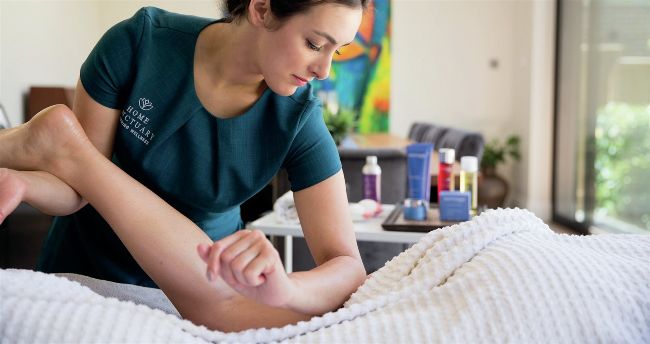MOBILE THERAPY
Making it mobile
Setting up as a mobile beauty therapist can be a daunting process, from sorting out the correct insurance to building a client base. Ellen Cummings asks three successful mobile beauty therapists for their top tips
Once the idea to set up a mobile beauty business strikes you, it might be tempting to dive straight in. However, there is a lot that needs to be considered first. “The main thing is to first have a business plan, where short-term goals will intertwine with the long-term goals,” says Bella Kowalska, owner of the Nail Bus, based in Lancashire. “It’s very easy to lose track of where you envisioned your business going as you get inundated in the daily grind of running it.”
Hayley Snishko, owner of Surrey-based Home Sanctuary and finalist in the Mobile/Home-based Beauty Business category at the 2023 Professional Beauty Awards, highlights that there is a bit of admin involved before you can start treating clients.
She explains,“You’ll need to decide whether to be self-employed or set up as a limited company. There are pros and cons to both options so be sure to seek proper advice from an accountant or business financial adviser before registering with HMRC. Some local authorities may require that you register your business with them. Check to see if you need to register your business before starting out.”
Which treatments to offer
The core part of your mobile beauty business is the services you offer to clients. But how do you decide what these should be? Snishko says, “This will depend on your qualifications, the potential client demand and what investment you have available. Have a look at the other mobile therapists in your target area and review which treatments are currently being offered. You can then decide to either compete with them or offer alternative treatments to attract different clients. You can always add new treatments as you develop your business, so don’t worry about trying to offer everything straight away.”
Amanda Hayes, owner of Oxfordshire-based mobile beauty service The Beauty Bus, agrees. “It’s always best to work within your means. Start with what you really want and can afford to do, then add more into your treatment menu when you start earning more,” she says.
As well as considering what prospective clients will want, you need to take your own comfort and security into account, as Snishko explains: “A very important consideration before visiting any clients is your personal safety. Will you only offer services to women or only book clients who have been referred? You may want to implement a process of speaking with any new client on the phone before an appointment is booked.”
The initial costs
Once you’ve created a business plan and decided which services you want to offer, you need to look at your finances. “While you’ll be able to launch a mobile therapy company with considerably less capital than a salon, there are still large costs you will need to consider before opening,” says Snishko. As a mobile therapist, being able to travel is crucial and finding the right vehicle should be one of your top considerations. Snishko explains, “You will need a reliable car. Of course, you can use public transport but this isn’t sustainable long term. To be able to carry out proper treatments, you will need to purchase the right equipment, and this is not something you can easily transport on the train. So, making sure you have a car with space for everything is a priority.”

Nail Bus interior and exterior
Of course, this becomes even more important if your vehicle doubles up as your treatment space. Commenting on her decision to convert an RV motorhome into a mobile salon, Hayes says, “I always knew I needed a vehicle large enough to suit me so that I’m not hunched over performing my treatments; one that could fit all my equipment and was spacious enough to be comfortable. Good posture is important to maintaining a long career in the beauty industry.”
Other investments to consider include equipment, products, booking systems and setting up an online presence. “When purchasing any equipment or tools to use for your clients, always ensure you are purchasing from a reputable seller. There are many professional wholesale companies that provide the best quality tools you need,” says Snishko.
She adds, “A booking system is key with beauty on demand. It’s best to research the options to find one that suits your business needs. You will also need a website. While there are free options available, I strongly recommend paying for a good site to be built.
“It is your shop window, particularly with mobile work. Clients will use it to evaluate you and the services you offer in order to gain trust and contact you, so it needs to look professional and have all the information you need to convey.” Looking after the financial side of a business might seem like a complicated task, but there are ways to make it easier for yourself, Snishko explains.
Financial considerations
“Once you’ve registered with HMRC, you’ll need to set up a bank account for your business. There are many new online business bank account options that offer free banking for basic accounts and invoicing options if you need them. I like to always have a six-month contingency balance in my account for any emergencies,” says Snishko.
Hayes adds, “The one critical piece of advice I cannot stress enough is to make sure you put aside a portion of what you make for the tax man. Before I even pay myself anything at the end of the month, I calculate what I have earned and put 20% of that into a separate bank account that is only for tax. This bank account I don’t ever touch unless it is to pay for the tax at the end of the year. Any extra that is left over once I have done my self-assessment is then divided up to go to either national insurance contributions or a private pension.
“It’s important to be sensible with the finance aspect of being a mobile therapist. You don’t want to find you get a huge tax bill that you can’t pay because that will instantly ruin you. There are so many banking apps these days that make your business finances so much easier. It’s a lot more user-friendly and you don’t need a degree to work out what you have coming in and going out.”
Getting insured
Insurance is essential as a mobile therapist to protect both you and your clients. “It will also show your clients that you are trained to the highest standards and a trusted therapist,” says Snishko. “To get your insurance verified, you’ll need to have the correct qualifications. Companies like Professional Beauty Direct, Babtac and FHT are all good organisations that provide insurance.” As a mobile therapist, you will also need to make sure your mode of transport is fully covered.
Snishko explains, “You will likely need to add a business policy on top of your existing car insurance, so speak with your provider to make sure your cover is correct. If you have an accident and haven’t declared business use, then your policy may be void.”
Hayes adds, “You’ll also need to consider public liability insurance to cover any accidents; for example, any accidental injuries or damage to property.”

The Beauty Bus inside and on the road
How far to go
“The beauty of being mobile is that you can travel as far and wide as you like, this is really an individual decision based on what your business is offering,” comments Kowalska.
Hayes advises that your area of practice can take time to establish. “During my start up, with a limited client base, I accepted clients all over the county. You just have to take what you can,” she says. “Now my client base is more established, I’ve been able to narrow down my working field. I work in certain areas on specific days and create routes that work for me – and clients are flexible to this.”
Snishko agrees that convenience is key. She explains, “My general radius is 30 miles. But for me, it’s not really about the radius, but rather the efficiency. If I’m booking just one client in a house, then I will have a minimum of a 90-minute treatment per appointment. I try to keep my bookings as close together as possible during the day. This enables me to fit in more clients while limiting my travel time. I will add additional travel fees if necessary, but I discuss this prior to my client’s appointment, and depending on what treatment they’re booking.”
Calculating prices
It can be difficult knowing where to start when figuring out what to charge clients for your services. Hayes suggests doing some research, commenting, “Look at competitors around you and see what they charge. It can take time to work out the cost of factors you can’t control like vehicle maintenance or fuel prices. Starting out, I was priced higher than the average beauty therapist because I didn’t want to constantly keep raising my prices. Two years on, I would say I’m in the average range. I will need to readjust my prices this year. The worst thing you can do is undersell yourself.”

Hayley Snishko at work
Snishko adds, “When you’re setting your prices, remember it’s harder to increase prices than it is to discount. Set your value from the get-go, and every year, be sure you increase prices in line with inflation.”
Being able to upsell is a great way to increase your profits. “Find a selection of add-on treatments you can offer your clients on the day that don’t take any additional time – face masks and foot treatments, for example,” suggests Snishko. “If 10 clients a week purchased a £10 add-on, that’s an additional £400 increase on your income every month
“Also consider the product ranges for extra sales revenue. Find a product range you love, and buy their retail products at trade price, which you can then sell in your business, making a profit margin. This will not only give your business brand strength credibility, but you will be earning extra income.”
Building a client base
Once you’ve completed all of the admin, sourced your vehicle and equipment, and got your finances in check, it’s time to start treating clients. But how do you build a loyal client base to make sure your business is profitable? “My best builder for a client base has been word of mouth but that can take time and is a slow build. When starting out, use social media as much as possible. Use hashtags of your local area and get your face known on your pages,” says Hayes.
Snishko adds, “Client referrals will eventually become the backbone of your business due to the nature of mobile therapy. People would rather be recommended to someone coming into their home by a trusted friend. I would implement a really great referral scheme to encourage your clients to tell their friends about you and your business. Don’t ever be afraid to ask your clients to recommend you to their friends.”
Getting involved in your local community is also a great opportunity to get the word out. “Try teaming up with a local company that offers related services to you and tapping into their client base,” says Snishko. “If you team up with a local yoga studio as a massage therapist, for example, you’ll have a long list of clients who will more than likely be interested in having massages. Approach a few business owners to see if they would be interested in arranging a ‘service swap’ so you can both experience what the other has to offer.”
Finally, continually updating your skills is crucial to providing the best service. Kowalska comments, “Keep up with trends and latest innovations in your industry. It’s forever moving and changing, and you can’t afford to be left behind.”